I may edit and revise these series often, as new technology comes out and things change over time...
Computer Help Part 1 of 10 - Hardware Terms
I've been working at the Geek Squad for a few years now (at the time of this writing), and we constantly see the same common mistakes made by most people over and over and over again. So, I decided to put together some basic advice, hints, and tips to help anyone reading this avoid making these same mistakes. These mistakes vary from not backing-up their important, irreplaceable data to using inadequate protection software to protect their computer from really nasty stuff. I've listed some websites along with some basic advice, hints, help, and tips in an honest attempt to keep this guide as small and easy-to-understand as possible. Whenever possible, I used Simple English Wikipedia at http://simple.wikipedia.com/ for most of these listings since their website usually goes into great detail, and they try to keep their pages basic enough for almost anyone to understand them, usually. If I couldn't find a related article on Simple English Wikipedia, then I used the normal Wikipedia. If this doesn't help, doing a Google search at http://www.google.com/ will sometimes provide better answers to your questions.
Computer Terminology
When your computer breaks, it's easier to know some basic terminologies of what to say when you bring your computer into a computer repair shop to get fixed, much like taking your vehicle to a mechanic. Also, many people confuse computer terminologies, and for the purpose of this blog, it's not a bad idea to familiarize yourself with the computer terminologies. You don't have to read all of them word-for-word, but just enough to get familiar with these basic terminologies. And believe it or not, unlike your vehicle, I can probably count how many parts are inside your computer on two hands! So, learning the different parts of a computer is the easy part. It's repairing them is what's often most difficult...

Desktop Computers: Often mistakenly called the "CPU", "modem", or the "hard drive", they're usually towers that sit upright and require a display (monitor, screen, etc.) to see what you're doing, a keyboard to type with, and a mouse to move your cursor around and click with. Referring to your computer as the "CPU", "modem", or the "hard drive" would be like referring to your vehicle as a "carburetor", a "spark plug", or an "engine", when these are just the parts that are inside of your vehicle. The CPU, modem, and the hard drive are simply parts inside of your computer.
http://en.wikipedia.org/wiki/Desktop_computer
Laptop Comp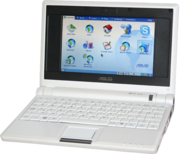 uters: Portable computers that has a built-in battery (so that you don't need to plug it in all of the time), a monitor, a keyboard, and often a TouchPad (a pad you move your finger around on to control the cursor, much like a computer mouse).
uters: Portable computers that has a built-in battery (so that you don't need to plug it in all of the time), a monitor, a keyboard, and often a TouchPad (a pad you move your finger around on to control the cursor, much like a computer mouse).
http://en.wikipedia.org/wiki/Laptop
Computer Hardware (usually covered by warranties): Any physical part of your computer that you can see and touch.
http://simple.wikipedia.org/wiki/Computer_hardware
These are the computer components (or parts) and devices of your computer:
Internal: Any Computer Components (or parts) that's inside your computer.
External: Any Computer Device or Peripheral (such as a Printer or a Scanner) that plugs into your computer from the outside.

http://simple.wikipedia.org/wiki/USB
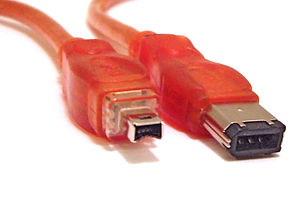 FireWire: Also known as IEEE 1394 (usually only geeks and nerds use this expression, though), it's a different type of port from USB, made specifically for certain types of devices, mostly digital video in nature, such as a digital video camcorder. However, there are a few other devices out there that'll let you plug it into the FireWire port, also. There's two varieties of FireWire, 4-pin and 6-pin, but the 6-pin is the most common. It's rectangular, like the USB port, but is rounded on one end. The 4-pin is most often used on the device itself, such as on a digital video camcorder, and is much smaller in comparison to the 6-pin. Most of the time, when you buy a FireWire device, you'll need to also buy a 4-pin to 6-pin FireWire cable with it, but it's always a good idea to check the box to see if it already comes with a FireWire cable.
FireWire: Also known as IEEE 1394 (usually only geeks and nerds use this expression, though), it's a different type of port from USB, made specifically for certain types of devices, mostly digital video in nature, such as a digital video camcorder. However, there are a few other devices out there that'll let you plug it into the FireWire port, also. There's two varieties of FireWire, 4-pin and 6-pin, but the 6-pin is the most common. It's rectangular, like the USB port, but is rounded on one end. The 4-pin is most often used on the device itself, such as on a digital video camcorder, and is much smaller in comparison to the 6-pin. Most of the time, when you buy a FireWire device, you'll need to also buy a 4-pin to 6-pin FireWire cable with it, but it's always a good idea to check the box to see if it already comes with a FireWire cable.
http://simple.wikipedia.org/wiki/Firewire
 eSATA: A newer, much faster connection than USB or FireWire, this connection is only used for external permanent storage devices (such as External Hard Drives). Most of these devices already come with an eSATA cable, but always check the box to see if it does come with one.
eSATA: A newer, much faster connection than USB or FireWire, this connection is only used for external permanent storage devices (such as External Hard Drives). Most of these devices already come with an eSATA cable, but always check the box to see if it does come with one.
http://en.wikipedia.org/wiki/ESATA#External_SATA
 Power Supply: Often abbreviated as PSU (Power Supply Unit), it distributes power to different parts inside of your computer. Most computers come with a basic Power Supply that's only made to power what originally came with the computer, and then some. If you upgrade your computer a lot, adding a lot of internal parts to it, especially a Video Card (discussed below), then you may need to upgrade the Power Supply to meet the power demands of your new computer parts.
Power Supply: Often abbreviated as PSU (Power Supply Unit), it distributes power to different parts inside of your computer. Most computers come with a basic Power Supply that's only made to power what originally came with the computer, and then some. If you upgrade your computer a lot, adding a lot of internal parts to it, especially a Video Card (discussed below), then you may need to upgrade the Power Supply to meet the power demands of your new computer parts.
http://en.wikipedia.org/wiki/Computer_power_supply
 Motherboard: The main, silicon circuit board in which everything else inside your computer plugs into. Think of the motherboard as the "traffic cop", sending and receiving information to the other components (parts) inside of your computer. If the motherboard doesn't work properly, then it's usually VERY obvious! If you change or upgrade your motherboard, anticipate buying a lot of other, newer computer parts that will work with the new motherboard! Unfortunately, new motherboards can rarely use old internal computer parts with them. So, most of the time, if you have an old computer with a dysfunctional motherboard, it's usually more cost-effective to just buy a whole new computer, unless you're "computer savvy" and can replace the motherboard without having to pay someone else to do it for you and having to buy other new computer components.
Motherboard: The main, silicon circuit board in which everything else inside your computer plugs into. Think of the motherboard as the "traffic cop", sending and receiving information to the other components (parts) inside of your computer. If the motherboard doesn't work properly, then it's usually VERY obvious! If you change or upgrade your motherboard, anticipate buying a lot of other, newer computer parts that will work with the new motherboard! Unfortunately, new motherboards can rarely use old internal computer parts with them. So, most of the time, if you have an old computer with a dysfunctional motherboard, it's usually more cost-effective to just buy a whole new computer, unless you're "computer savvy" and can replace the motherboard without having to pay someone else to do it for you and having to buy other new computer components.
http://simple.wikipedia.org/wiki/Motherboard
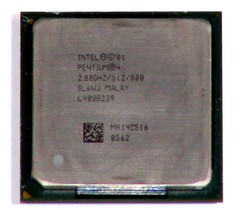 Processor: Also known as the CPU (Central Processing Unit), it "processes" (hence, the name) information sent to it, and then, in turn, sends the processed information back out. Think of it as the "brain" of your computer, taking on multiple tasks such as displaying your video, sending out your audio, and so forth. The processor is just a small chip that sits on your motherboard with usually a really big fan and/or heatsink on it to keep it cool. Most processors come with multiple cores, meaning that it's like having two, three, or even four brains inside one head! Having multiple cores doesn't make your computer run any faster, but just that it's able to handle multiple tasks without slowing down as much.
Processor: Also known as the CPU (Central Processing Unit), it "processes" (hence, the name) information sent to it, and then, in turn, sends the processed information back out. Think of it as the "brain" of your computer, taking on multiple tasks such as displaying your video, sending out your audio, and so forth. The processor is just a small chip that sits on your motherboard with usually a really big fan and/or heatsink on it to keep it cool. Most processors come with multiple cores, meaning that it's like having two, three, or even four brains inside one head! Having multiple cores doesn't make your computer run any faster, but just that it's able to handle multiple tasks without slowing down as much.
http://simple.wikipedia.org/wiki/Processor
 System Memory: Also known as RAM (Random Access Memory), this is often mistaken for permanent storage. When you do something on your computer, some or all of it is temporarily stored in your System Memory, which is much faster than permanent storage. The more System Memory you have, the more information that can be temporarily stored, thus increasing your computer's speed. Please refer to the analogy between System Memory and permanent storage below in Hard Disk Drives.
System Memory: Also known as RAM (Random Access Memory), this is often mistaken for permanent storage. When you do something on your computer, some or all of it is temporarily stored in your System Memory, which is much faster than permanent storage. The more System Memory you have, the more information that can be temporarily stored, thus increasing your computer's speed. Please refer to the analogy between System Memory and permanent storage below in Hard Disk Drives.
http://simple.wikipedia.org/wiki/Computer_memory
 HDD (Hard Disk Drive): Or most often just called the Hard Drive, this is permanent storage inside your computer that's often mistaken for System Memory (discussed above). This is where all of your information is stored, such as Microsoft Windows, your documents, pictures, music, etc. Think of your Hard Drive as the "filing cabinent" where all of your files and folders are stored, whereas System Memory as your desk where you can have several files and folders open at a time. The bigger your "filing cabinet" (Hard Disk Drive) is, the more files and folders you can store. The bigger your "desk" (System Memory) is, the more files and folders you can have open at any given time. There's also two types of hard disk drives, (E)IDE and SATA. If you ever need to change your Hard Drive, always make sure what kind of Hard Drive it can use, because the two types aren't interchangeable! Changing to a larger hard disk drive usually doesn't increase your speed, but does help you store more information if you're about to run out.
HDD (Hard Disk Drive): Or most often just called the Hard Drive, this is permanent storage inside your computer that's often mistaken for System Memory (discussed above). This is where all of your information is stored, such as Microsoft Windows, your documents, pictures, music, etc. Think of your Hard Drive as the "filing cabinent" where all of your files and folders are stored, whereas System Memory as your desk where you can have several files and folders open at a time. The bigger your "filing cabinet" (Hard Disk Drive) is, the more files and folders you can store. The bigger your "desk" (System Memory) is, the more files and folders you can have open at any given time. There's also two types of hard disk drives, (E)IDE and SATA. If you ever need to change your Hard Drive, always make sure what kind of Hard Drive it can use, because the two types aren't interchangeable! Changing to a larger hard disk drive usually doesn't increase your speed, but does help you store more information if you're about to run out.
http://simple.wikipedia.org/wiki/Hard_drive
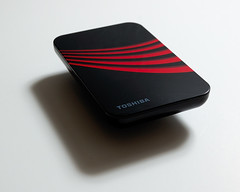 External Hard Drives: These Hard Drives are portable, making permanent storage that you can take to different computers to access your information from. People often use these to backup (or copy) their important information to, which is a very good idea. Most of them are basically a Hard Disk Drive inside a plastic protective box that can easily plug-into your computer externally. And since they're basically a Hard Drive, they can hold a lot of information, as much as what an Internal Hard Drive can hold. Most External Hard Drives are USB, some External Hard Drives are FireWire, and a few are the newer, faster eSATA hard drives.
External Hard Drives: These Hard Drives are portable, making permanent storage that you can take to different computers to access your information from. People often use these to backup (or copy) their important information to, which is a very good idea. Most of them are basically a Hard Disk Drive inside a plastic protective box that can easily plug-into your computer externally. And since they're basically a Hard Drive, they can hold a lot of information, as much as what an Internal Hard Drive can hold. Most External Hard Drives are USB, some External Hard Drives are FireWire, and a few are the newer, faster eSATA hard drives.
 Flash Drives: Also called jump drives, pen drives, and thumb drives, they're another smaller form of portable, permanent storage. These little drives are great for carrying around smaller amounts of information, such as documents, spreadsheets, small amount of pictures, and the such.
Flash Drives: Also called jump drives, pen drives, and thumb drives, they're another smaller form of portable, permanent storage. These little drives are great for carrying around smaller amounts of information, such as documents, spreadsheets, small amount of pictures, and the such.
http://simple.wikipedia.org/wiki/USB_flash_drive
 Optical Disc Drive: These drives can read discs, such as CDs or DVDs, and can often "burn" (or write) to these types of blank discs. And no, don't mistake it for a drink holder! LOL Sorry, old computer joke. ;-) There's many different types of optical drives...
Optical Disc Drive: These drives can read discs, such as CDs or DVDs, and can often "burn" (or write) to these types of blank discs. And no, don't mistake it for a drink holder! LOL Sorry, old computer joke. ;-) There's many different types of optical drives...
- CD-ROM Drives: Can only read CDs, but not DVDs (commonly known CD drives)
- CD-RW Drives: Can read and burn CDs, but not DVDs (commonly known as CD burners)
- Combo Drives: Can read and burn CDs, but can only read DVDs
- DVD-RW Drives: Can read and burn both CDs and DVDs (commonly known as DVD burners)
- DVD-RW+DL Drives: Can read and burn to CDs, DVDs, and DVD+DL discs (commonly known as Double or Dual-Layered DVD burners, which can hold twice as much information as regular DVD discs)
- Blu-Ray burners, that can do all of the above, plus also write to Blu-ray discs.
And then, to complicate things even more, there's "+" (plus) and "-" (minus) recordable DVDs, along with ReWritable (RW) discs, and finally LightScribe drives and discs. To simplify things, I highly recommend only using "+" (plus) blank DVDs, but if you're burning videos onto DVDs to playback on a DVD player, then you'll have to test your burnt DVDs with your DVD players. Most DVD players will playback either "+" (plus) or "-" (minus) DVDs, but some of the really old, first generation DVD players may only playback one or the other. If you're using one of the first DVD players that came out, then you'll have to try either type to see what works, along with anyone else you give your DVD copies to. And as tempting as ReWritable discs are to use, only store not-so-important information on these. Over time, ReWritable discs' quality can degrade (get worse), and you may start losing important information of these! LightScribe can "etch" a label on top of the disc, such as letters, numbers, and even pictures, but you MUST use LightScribe discs with a LightScribe burner to do this.
http://simple.wikipedia.org/wiki/Optical_drive

http://en.wikipedia.org/wiki/Expansion_card
 Dial-Up Modem: Used to dial-up to another computer using your telephone line, such as connecting to the internet. Most common dial-up ISPs (Internet Service Providers) are AOL (America Online), EarthLink, Juno, NetZero, and PeoplePC Online. http://simple.wikipedia.org/wiki/Modem
Dial-Up Modem: Used to dial-up to another computer using your telephone line, such as connecting to the internet. Most common dial-up ISPs (Internet Service Providers) are AOL (America Online), EarthLink, Juno, NetZero, and PeoplePC Online. http://simple.wikipedia.org/wiki/Modem NIC (Network Interface Card): Most network cards are integrated (built-into) the motherboard. Also known as the ethernet port, it connects the computer to both a LAN (Local Access Network, or a home network) and a WAN (Wide Area Network, such as the Internet). This type of connection allows you to share information between different computers in your house, and also share the Internet connection between your computers, if you use a router. Most broadband (fast access Internet) services, such as cable and DSL, use this port to connect your computer to the Internet, and require a broadband modem (not to be confused with the dial-up modem mentioned above) to do so. And to make things even more confusing, there's a variety of wireless network cards also, so you can connect your laptop to a wireless router and get on the Internet from most parts of your house without the constraints of cables! http://simple.wikipedia.org/wiki/Network_card
NIC (Network Interface Card): Most network cards are integrated (built-into) the motherboard. Also known as the ethernet port, it connects the computer to both a LAN (Local Access Network, or a home network) and a WAN (Wide Area Network, such as the Internet). This type of connection allows you to share information between different computers in your house, and also share the Internet connection between your computers, if you use a router. Most broadband (fast access Internet) services, such as cable and DSL, use this port to connect your computer to the Internet, and require a broadband modem (not to be confused with the dial-up modem mentioned above) to do so. And to make things even more confusing, there's a variety of wireless network cards also, so you can connect your laptop to a wireless router and get on the Internet from most parts of your house without the constraints of cables! http://simple.wikipedia.org/wiki/Network_card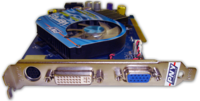 Video Card: Most video cards are integrated (built-into) the motherboard, but if you play a lot of high-quality, graphical games, do video editing, or use CAD, then you'll definitely want to upgrade to a better video card! Most of the integrated video cards that come with most computers are mostly made for low-graphics, such as word processing, web browsing, e-mail, low-quality games such as Solitaire, and the such. There are three flavors of video cards: PCI, AGP, and PCI Express, and you'll always want to make sure that you get the right one for your computer! A very common problem with video cards is basically the computer turns-on and you can hear it running, but you have no display or video. If you upgrade your video card, anticipate upgrading your power supply, also! Most video cards require a lot of juice to run properly. http://simple.wikipedia.org/wiki/Graphics_card
Video Card: Most video cards are integrated (built-into) the motherboard, but if you play a lot of high-quality, graphical games, do video editing, or use CAD, then you'll definitely want to upgrade to a better video card! Most of the integrated video cards that come with most computers are mostly made for low-graphics, such as word processing, web browsing, e-mail, low-quality games such as Solitaire, and the such. There are three flavors of video cards: PCI, AGP, and PCI Express, and you'll always want to make sure that you get the right one for your computer! A very common problem with video cards is basically the computer turns-on and you can hear it running, but you have no display or video. If you upgrade your video card, anticipate upgrading your power supply, also! Most video cards require a lot of juice to run properly. http://simple.wikipedia.org/wiki/Graphics_card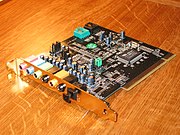 Sound Card: Most sound cards are integrated (built-into) the motherboard. Unless you're doing high-quality sound editing or using a really high-end speaker system connected to your computer, most people never need to upgrade their sound card, unless the integrated sound card stops working and you have no sound. http://simple.wikipedia.org/wiki/Sound_card
Sound Card: Most sound cards are integrated (built-into) the motherboard. Unless you're doing high-quality sound editing or using a really high-end speaker system connected to your computer, most people never need to upgrade their sound card, unless the integrated sound card stops working and you have no sound. http://simple.wikipedia.org/wiki/Sound_card
 Cable/DSL Modem: Not to be confused with a dial-up modem (discussed above), this little box is used to connect your computer to broadband internet through your cable or phone (DSL) company.
Cable/DSL Modem: Not to be confused with a dial-up modem (discussed above), this little box is used to connect your computer to broadband internet through your cable or phone (DSL) company.
Router: This is a box that connects in-between your cable/DSL modem and your computers. This little box allows you to share your information and even your printer between your computers, along with your broadband internet connection. Think of your router as nothing more than a "splitter", in which it splits your broadband internet connection between your computers much like a video splitter splits your cable TV between different TVs in your house.
 Wireless Router: This little box has the same capabilities as a regular router, but a wireless router even lets you connect your computers together and to your broadband internet without the use of cables! Since most laptops already come with a wireless NIC (Network Interface Card) built-in, simply adding a wireless router allows you to connect to your laptop to your broadband internet throughout most parts of your house without the use of any cables! However, much care is needed when installing a wireless router, since it's an open signal that anyone else nearby can connect to, also. If someone can connect to your wireless router outside of your house, then they have access to any important, private information on any of your computers! So, read through any materials carefully that came with your wireless router to securely setup it up (basically, add a password so no one without the password can access your computers). If you have issues setting-up your wireless router, you can always have someone, like Best Buy's Geek Squad, come out to your house and setup your wireless router so that you can share information and printers between your computers, and also add security to keep strangers out!
Wireless Router: This little box has the same capabilities as a regular router, but a wireless router even lets you connect your computers together and to your broadband internet without the use of cables! Since most laptops already come with a wireless NIC (Network Interface Card) built-in, simply adding a wireless router allows you to connect to your laptop to your broadband internet throughout most parts of your house without the use of any cables! However, much care is needed when installing a wireless router, since it's an open signal that anyone else nearby can connect to, also. If someone can connect to your wireless router outside of your house, then they have access to any important, private information on any of your computers! So, read through any materials carefully that came with your wireless router to securely setup it up (basically, add a password so no one without the password can access your computers). If you have issues setting-up your wireless router, you can always have someone, like Best Buy's Geek Squad, come out to your house and setup your wireless router so that you can share information and printers between your computers, and also add security to keep strangers out!
There's quite a few free utilities you can use to diagnose (test) your computer hardware, but many of these take quite a bit of "know-how" to use them! Here's a list:
System Memory Diagnostic:
- MemTest86 at http://www.memtest86.com/
- MemTest86+ at http://www.memtest.org/
Hard Drive Diagnostics:
- Hitachi's DFT (Disk Fitness Test) at http://www.hitachigst.com/hdd/support/download.htm
- Seagate's SeaTools at http://www.seagate.com/www/en-us/support/downloads/seatools
- WD's (Western Digital's) Data Lifeguard Diagnostics at http://support.wdc.com/product/download.asp?lang=en
General/Miscellaneous Diagnostics:
- UBCD (Universal Boot CD) at http://www.ultimatebootcd.com/
- UBCD4Win (Universal Boot CD For Windows, a graphical version of UBCD) at http://www.ubcd4win.com/.
These utilities aren't for the weak at heart, and you'll need a bit computer "know-how" on how to make and use them!!! Some of these utilities come with a lot of software that can easily erase your hard drive if you aren't careful!!! Always backup your important information before using any kind of utilities such as these (covered in Computer Help Part 4 of 10 - Data BackUp)! Also, I can't be held responsible for what damage these utilities may do! This doesn't happen very often, but it can happen. Use these utilities AT YOUR OWN RISK! If you are able to use these utilities effectively, then please donate to to the ones that accept donations so the software writers are able to continue their free projects.
Now, onto Computer Help Part 2 of 10 - Software Terms...
- Computer Help Part 1 of 10 - Hardware Terms (Current)
- Computer Help Part 2 of 10 - Software Terms (Next)
- Computer Help Part 3 of 10 - Upgrading & Maintenance
- Computer Help Part 4 of 10 - Data BackUp
- Computer Help Part 5 of 10 - Recovery Discs
- Computer Help Part 6 of 10 - Protection Software
- Computer Help Part 7 of 10 - Free Software
- Computer Help Part 8 of 10 - Not-So-Free Software
- Computer Help Part 9 of 10 - Scheduled Tasks
- Computer Help Part 10 of 10 - Quick Fixes (End)
1 comment:
I clearly understand the rule before I give my reaction here, I just wanna say that I like this blog because it's almost same as the page of computers hardware Chicago IL.
Post a Comment